
|
OBP Cures Tennis Elbow - A new Approach to a Difficult Problem!
|
The Therapeutic Challenge: Maximize Healing, Minimize Damage.
Tennis elbow manifests itself when healing cannot
outpace the rate of damage (see diagram). Your tennis elbow strategy
will build itself around this. All we have to do is
list the healing factors, and optimize them, and then list the damage factors
and minimize them.
|
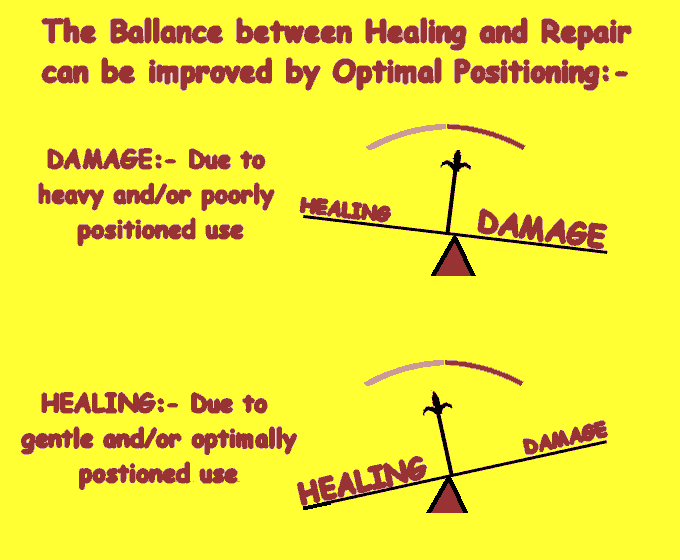
|
Core Concept:
"OBP" (Optimal Body Positioning) in wrist and forearm is the unifying key concept
behind most of the things that you can do to maximize healing and minimize damage in
your Tennis Elbow tendon. The OBP concept will be used extensively in the following discussion.

Management of Tennis Elbow: Theory
This section is presented in three parts:-
- Optimal Body Positioning, "OBP" at rest
- Optimal Body Positioning "OBP" in use.
- Other Tennis Elbow Remedies

(1) Optimal Body Positioning at rest:
Get to Know your Body Exercise 1: Positioning "at Rest"
This one assumes you have a "sore tennis elbow"; but if you haven't, try it anyway. |
Note the positioning of your wrist as you hold the steering wheel of the car (or
as you rest your hand on the computer key board, or on the mouse)! Chances are, (and if
you are anything like me!), the wrist of your tennis elbow arm is not in neutral,
but rather is in extension or dorsi-flexion.
The position pictured to the right constitutes
a "DSM" of the wrist joint. A "DSM" is a Directional
Susceptibility of Movement. Professor of Physiotherapy Shirley Sahrmann
describes it thus:- "The impairments
of soft tissues induced by repeated movements and sustained postures eventually causes
a joint to develop a susceptibility to movement in a specific direction..." (Ref 4, page 4).
In fact, wrist dorsi-flexion is probably
the main DSM associated with tennis elbow. |
The resting position of the "tennis elbow" wrist. (Dorsi-flexion)This constitutes the major "DSM"
of Tennis Elbow.
 |
As will be demonstrated in the exercises that follow, this (sub-optimal) wrist
positioning or "DSM" leads to an increase in tension of the forearm muscles, and especially
the ECRB muscle. This increase in muscle tension at rest is bad for the following reasons:-
- Constantly pulls the broken ends of the ECRB tendon apart making it
difficult for the tendon to pull together and heal.
- Constantly increases the pressure within the healing area, making it harder
for the blood to flow into the healing area.
- Enhances the "splinting effect": This is when muscles around a broken or painful bone
tend to go into spasm in an attempt to stabilize the fractured bone. This is
something I observe when pinning a dog's leg. The same sort of "splinting effect"
can happen when tendinous and joint capsule attachments to the bone become inflamed
and painful. "Splinting" certainly occurs when a dog dislocates its hip, or when a human
dislocates the shoulder, and also occurs in the ECRB and neighbouring muscles when
there is tennis elbow pain. I already stated that surgical repair of the ECRB tendon
immediately removes tennis elbow pain and encourages normal forearm function. This suggests
that surgery not only removes the damaged "jelly like" material in the tendon, but
that it also removes increased or overactive pain receptors from the area, thus
also removing the "splinting" stimulus.
|
OBP brings New Understanding to Cures for Tennis Elbow and other Musculo-tendinous Injuries!
|
(2) Optimal Body Positioning, "OBP" in use.
(A) When the wrist and forearm is at OBP during use, the muscles carry
the least amount of wrist stabilizing tension.
| "Get to know your Forearm" Exercise 2: Signing your name:-
|
- Sign you name with your wrist maximally flexed! Feel the arm tension
and lack of control!
- Now sign your name with your wrist maximally extended! Again, feel
the tension and lack of control!
- Now sign your name with your wrist at exactly half way between flexed and extended.
(This is the OBP position!)
- (Note: this exercise assumes you are right handed.
If you are left handed, try the alternative of drawing a circle).
|
At this stage you are starting to be aware that extremes of wrist positioning create extremes of muscle tension.
It is normal and natural for your forearm muscles to carry tension.
Indeed, your wrist would collapse if the muscles did not carry some
tension. But excessive tension will lead to damage.
"Get to Know your Forearm" Exercise 3: Finding the least tense positioning
of the forearm and wrist:-
|
(1) Place your right hand over the muscles of your left forearm.
| 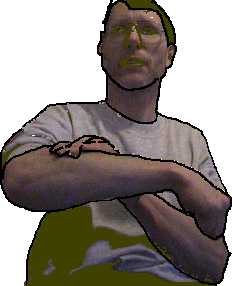 |
(2) Put the left wrist through its full range of flexion and extension.
Note when the muscle become tense! |
 |
(3)Put your left wrist through its full range of medial and lateral
flexion (see diagram). Note when the muscles become tense! |
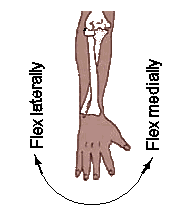 |
(4)Finally put your wrist through its full range of pronation and
supination. Again, note when the muscles become tense! | 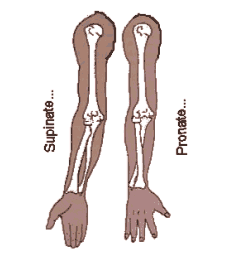 |
At this stage, you will be aware that your forearm muscles carry the least
tension somewhere in the "middle range" of wrist and forearm
movement. The following two diagrams define this "optimal middle range of flexion:-
| Defining optimal middle Range of Flexion for the Wrist. |
Diagram: Angle of Wrist Flexion
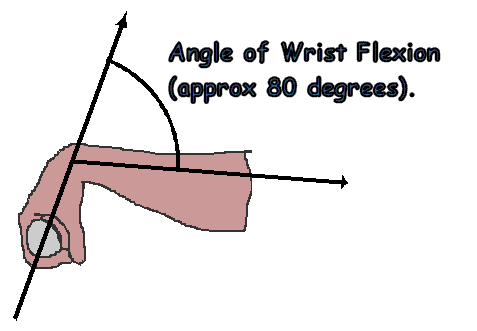 |
Graph: Depicts the degree of forearm muscle tension from 90 degrees of
flexion to 45 degrees of extension
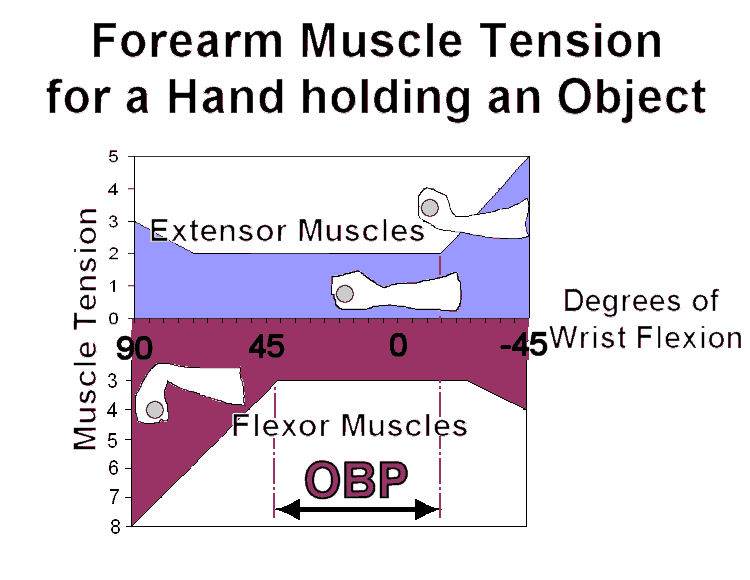 |
| The wrist flexion range from -15 degrees
to 45 degrees is the range of minimum muscle tension: I.e. the "OBP" of wrist flexion. |
Excessive tension will increase the loading on both muscle and tendon,
and therefore increase the rate of damage. The wrist flexion range from -15 degrees
to 45 degrees is the range of mimimum muscle tension, and this defines
the most important measurement of OBP for your wrist. Keep the wrist within these
angles, during all work and rest periods, and you will be putting the healing to
damage balance back in your tennis elbow's favour!

(B) When the wrist and forearm is at OBP during use, the muscles are at
their strongest.
- At the comfortable middle range, a muscle is able to generate its
greatest degree of force, whether that force is used for bracing or for moving.
(see diagram below).
- At its comfortable middle range, the muscle is best able to maintain
control by use of the least amount of tension.
- More important however is that for a given load, the muscle at
middle range is using the least percentage of its full power, and
is therefore least likely to tire with repetition, and eventually
buckle under the load, thereby stretching to beyond its optimal
length and putting greater strain on itself and its neighbouring
muscles joints and ligaments.

| OBP brings a totally new and safe approach
to cures for tennis elbow and other repetitive strain injuries.
Try comparing what you have just learned with what is available online!- |
|
Cures Tennis Elbow
|

Return to top...
Return to Top |
Proceed to page 3...
© Bruce Thomson, EasyVigour Project

|
|
|
|